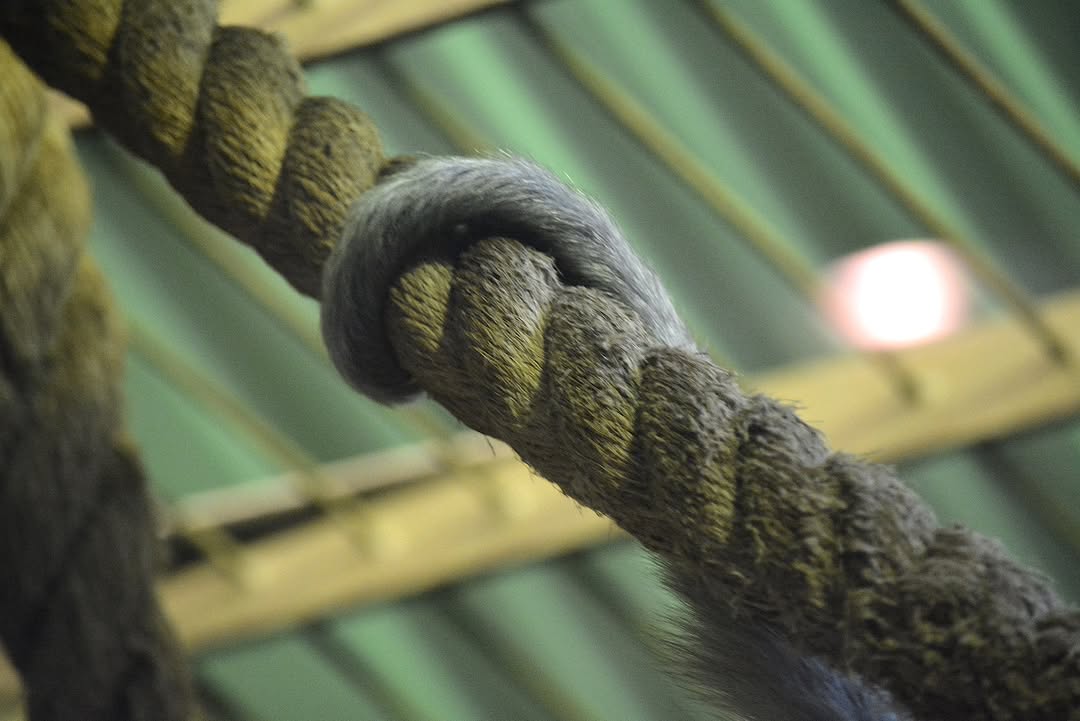- The anatomy and significance of the spider monkey’s prehensile tail
- Unique social dynamics of female spider monkeys
- Indoor habitat and its importance for spider monkeys at the zoo
- The role of zoos in conservation and education of spider monkeys
- Challenges facing spider monkeys in the wild and conservation efforts
Spider monkeys are some of the most fascinating primates in terms of anatomy and behavior. One of their distinct features is a prehensile tail, capable of supporting their entire body weight. This tail, effectively functioning as a fifth limb, plays a crucial role in their arboreal lifestyle, enabling them to perform tasks such as climbing and foraging with impressive dexterity. Each tail bears distinct patterns, akin to the human fingerprint, which makes each spider monkey distinct within their social groups and for caretakers who monitor them. This unique adaptation aids in stabilizing their movement through the dense canopy, highlighting their evolutionary development to survive and thrive in high forest areas.
Within the zoo environment, understanding the anatomy and behavioral implications of the spider monkey’s tail assists in designing suitable habitats and enrichment programs that mimic their natural settings. The tail allows them to swing and grip branches, giving them unparalleled mobility in their habitats. Observational studies conducted in controlled settings like zoos contribute to understanding how these animals interact with their environment, which informs conservation and breeding programs worldwide. Reliance on their tails for movement and interaction underscores the critical need for expansive and multidimensional enclosures that accommodate their active nature.
At the zoo, three female spider monkeys present an engaging dynamic that offers significant learning experiences for visitors and zoologists alike. Female spider monkeys typically lead complex social structures, with strong bonds forming within the troop. Social grooming, play, and mutual support are predominant behaviors observed, which serve as essential aspects of their social interactions. The females play pivotal roles in raising young and ensuring troop cohesion. With females often acting as the nucleus of their social group, their interactions can offer insights into primate social behavior and gender roles within primate communities.
Zoo environments serve as both sanctuaries and research hubs, allowing for an in-depth investigation into primate behaviors and interactions without the immediate threats present in the wild. The indoor habitat provided for the spider monkeys in the Castle, strategically situated between the Emperor Tamarin family and the Orangutans, ensures that they have the right temperature control and enrichment to live healthy and stimulated lives, particularly during extreme weather conditions. Effective zoo habitats must balance functionality with enrichment to prevent boredom and stress in captive animals. Through careful habitat design inclusive of areas that mimic their natural canopy, spider monkeys at the zoo engage in behaviors that echo their wild counterparts.
The role of zoos transcends mere display, encompassing conservation, species preservation, and public education. For spider monkeys, currently facing habitat loss and hunting pressures, zoos act as safe havens for maintaining genetic diversity and fostering future generations. Breeding programs in cooperative conservation efforts have seen success in maintaining stable captive populations of spider monkeys, thus acting as a safeguard against possible extinction scenarios. Through these programs, zoos contribute to the broader conservation community’s endeavors to preserve not only the species but also the ecosystems they inhabit.
Moreover, zoos provide educational platforms that raise public awareness about the plight of spider monkeys. With deforestation and illegal wildlife trade presenting challenges in the wild, educating zoo visitors about these issues can influence public perceptions and encourage citizenship actions to support conservation initiatives. Through interactive exhibits, talks, and demonstrations, visitors can develop an appreciation for these primates, which can translate into broader environmental stewardship.
In the wild, spider monkeys face several challenges that threaten their survival. Habitat destruction, primarily due to logging and agricultural expansion, is a significant concern, reducing the available forested areas they can inhabit. Additionally, spider monkeys have become targets for the pet trade and hunting, further exacerbating their population decline. Conservation organizations are tackling these issues by establishing protected areas, enforcing wildlife protection laws, and conducting conservation education programs aimed at local communities.
Research partnerships between zoos and conservation bodies are pivotal in devising strategies to mitigate these threats. By studying both in-situ and ex-situ populations, conservationists gather data essential for informed decision-making and intervention planning. Furthermore, engaging local communities in conservation efforts is vital, ensuring sustainable coexistence alongside these remarkable primates. Conservation success hinges on coordinated efforts at both local and global scales, incorporating scientific research, legal frameworks, and community engagement to secure a future for spider monkeys.
The collective strategic emphasis on habitat protection, population monitoring, and public education underscores an integrated approach to spider monkey conservation. As arboreal ambassadors, they symbolize broader conservation principles aimed at balancing human activities with wildlife preservation. Protecting spider monkeys encompasses safeguarding biodiversity and maintaining ecological integrity, which are essential for the health of our planet.
Ultimately, by observing the spider monkeys at the zoo, whether seamlessly swinging in their indoor habitat or engaging socially with one another, visitors gain insight into the complexity of primate life and the pivotal role these animals play in tropical ecosystems. This understanding fosters a deeper appreciation for conservation efforts and underscores the importance of maintaining biodiversity. As visitors learn about these primates and the challenges they face, they become part of a global community committed to the preservation of these and other species for future generations.
*****
Source Description
Tuesday Tails : Spider Monkeys
At the Zoo, we have three female spider monkeys. Spider monkeys have a prehensile tail that can support their entire body weight. Their tail acts as a fifth limb, helping them climb through their habitats, forage, and eat. Each tail has a print that is unique to them, much like your fingerprint!
When visiting on a warmer day, you can find our spider monkeys in their indoor habitat in the Castle between the Emperor Tamarin family and the Orangutans.


